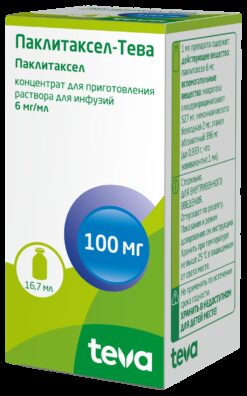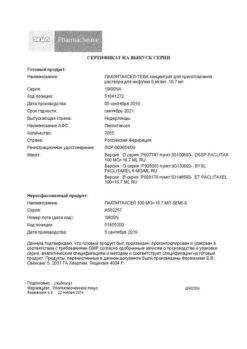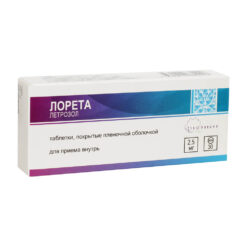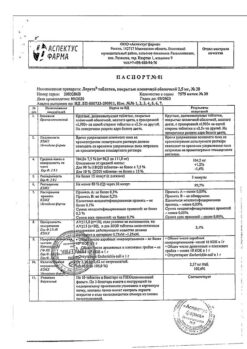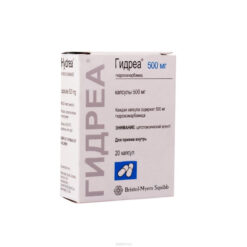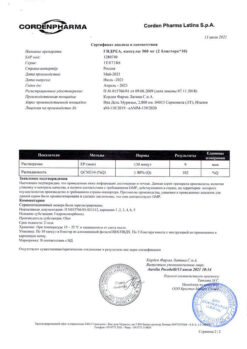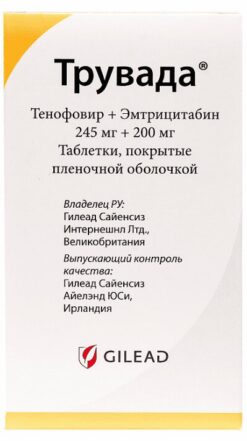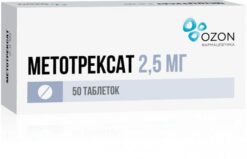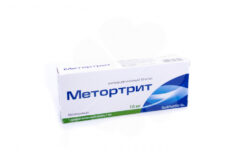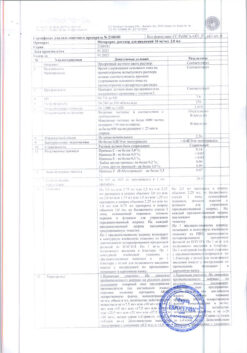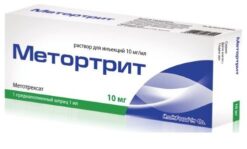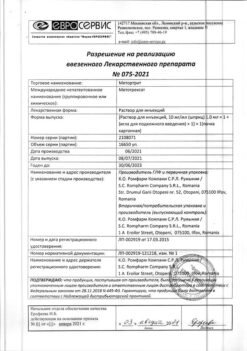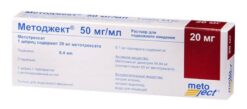No products in the cart.
Description
The antitumor agent is a protein tyrosine kinase inhibitor.
ATX code: L01XE26.
Pharmacological properties
Pharmacodynamics:
Cabozantinib is a small molecule inhibitor of various receptor tyrosine kinases involved in tumor growth, angiogenesis, bone remodeling, drug resistance formation and metastasis formation.
The inhibitory activity of cabozantinib has been evaluated against a range of kinases, and cabozantinib has been identified as an inhibitor of MET (hepatocyte growth factor receptor) and VEGF (vascular endothelial growth factor).
In addition, cabozantinib inhibits other tyrosine kinases including GAS6 receptor (AXL), RET, ROS1, TYR03, MER, stem cell growth factor receptor (KIT), TRKB, Fms-like tyrosine kinase-3 (FLT3) and TIE-2.
In preclinical studies, cabozantinib has shown dose-dependent reduction of tumor growth, tumor regression and/or suppression of metastasis in a significant number of different tumor models.
Pharmacokinetics:
Intake
After oral administration of cabozantinib, maximum plasma concentrations (Cmax) are reached after 3-4 hours. A second peak of maximum plasma concentrations of the drug is observed 24 hours after administration of cabozantinib, which may indicate intestinal-hepatic recirculation of the drug.
Recurrent daily administration of cabozantinib at a dose of 140 mg for 19 days showed an approximately 4-5-fold increase in cabozantinib exposure (AUC, area under the pharmacokinetic “concentration-time” curve) compared to a single dose administration. Equilibrium concentrations of cabozantinib are reached at about day 15.
In healthy volunteers, a single dose of cabozantinib at 140 mg along with a high-fat meal results in a 41% and 57% increase in Cmax and AUC, respectively, compared to fasting meal. Food intake 1 hour after drug intake has no effect on the absorption of cabozantinib.
Distribution
Cabozantinib in vitro is significantly bound to human plasma proteins (≥99.7%). Calculated on the basis of a population pharmacokinetic model, the volume of distribution (VZ) is about 319 l (SE: ± 2.7%). Protein binding was not altered in patients with mild to moderate renal or hepatic impairment.
Metabolism
The metabolism of cabozantinib was evaluated in vivo. Four metabolites of the drug were determined in plasma with an exposure (AUC) 10% greater than that of the parent substance: XL184-N-oxide, XL184 amide cleavage product, XL184 monohydroxysulfate, and 6-desmethylamide sulfate cleavage product.
The exposure of unconjugated metabolites (XL184-N-oxide and XL184 amide cleavage product) with less than 1% of the activity of the parent cabozantinib is less than 10% each of the total exposure of the drug in plasma.
Cabozantinib is a substrate of the CYP3A4 isoenzyme in vitro; neutralizing antibodies to CYP3A4 inhibit the formation of the metabolite XL184-N-oxide by more than 80% in NADPH-dependent human liver microsomes. In contrast, neutralizing antibodies to CYP1A2, CYP2A6, CYP2B6, CYP2C8, CYP2C19, CYP2D6, and CYP2E1 had no effect on the formation of cabozantinib metabolites.
Neutralizing antibodies to CYP2C9 had minimal effect on the metabolism of cabozantinib (metabolite content was reduced by less than 20%).
Elevation
In a population pharmacokinetic analysis of cabozantinib using data collected from 318 patients with renal cell carcinoma and 63 healthy volunteers after oral doses of 60 mg, 40 mg and 20 mg, the plasma elimination half-life of cabozantinib is approximately 99 hours.
The mean clearance (CL/F) at equilibrium was 2.2 L/hour. After a single administration of radioactively labeled [14C]-cabozantinib in healthy volunteers, the level of radioactivity excreted within 48 hours was about 81% of the total radioactivity administered, of which 54% was excreted with feces and 27% with urine.
Patients with impaired renal function
. Results from a study in patients with renal impairment indicated that the Cmax and AUC0-inf of cabozantinib were 19% and 30% higher in patients with mild renal impairment (90% CI for Cmax of 91,60% to 155.51%, AUC0-inf 98.79% to 171.26%) and 2% and 6-7% higher (90% CI for Cmax 78.64% to 133.52%, AUC0-inf 79.61% to 140.11%) for patients with moderate renal failure compared with patients with normal renal function.
The use of cabozantinib in patients with severe renal impairment has not been studied.
Patients with impaired hepatic function
The results of the study in patients with hepatic impairment show that exposure (AUC0-inf) increased by 81% and 63% in patients with mild hepatic impairment and moderate hepatic impairment, respectively (90% CI for AUC0-inf: 121.44% to 270.34% for mild and 107.37% to 246.67% for moderate).
The use of cabozantinib in patients with severe hepatic impairment has not been studied.
Race
Population pharmacokinetic analysis showed no clinically significant differences in cabozantinib pharmacokinetics by race.
Indications
Indications
Cabometyx® is indicated for the treatment of advanced renal cell carcinoma:
in adult patients with an intermediate or poor prognosis who have not previously received therapy;
in adult patients after previous therapy with antiangiogenic drugs (VEGF-targeted therapy).
Cabometyx® is indicated as monotherapy for the treatment of hepatocellular carcinoma in adult patients following prior therapy with sorafenib.
Pharmacological effect
Pharmacological effect
Antitumor agent – protein tyrosine kinase inhibitor.
ATX code: L01XE26.
Pharmacological properties
Pharmacodynamics:
Cabozantinib is a small molecule inhibitor of various receptor tyrosine kinases involved in tumor growth, angiogenesis, bone remodeling, drug resistance and metastasis.
The inhibitory activity of cabozantinib has been assessed against a range of kinases, and cabozantinib has been identified as an inhibitor of MET (hepatocyte growth factor receptor) and VEGF (vascular endothelial growth factor).
In addition, cabozantinib inhibits other tyrosine kinases, including GAS6 receptor (AXL), RET, ROS1, TYR03, MER, stem cell growth factor receptor (KIT), TRKB, Fms-like tyrosine kinase-3 (FLT3), and TIE-2.
In preclinical studies, cabozantinib demonstrated dose-dependent reduction in tumor growth, tumor regression, and/or inhibition of metastasis in a significant number of different tumor models.
Pharmacokinetics:
Suction
Following oral administration of cabozantinib, maximum plasma concentrations (Cmax) are achieved within 3-4 hours. A second peak in plasma drug concentrations occurs 24 hours after cabozantinib administration, which may indicate enterohepatic recirculation of the drug.
Repeated daily dosing of cabozantinib 140 mg for 19 days resulted in an approximately 4- to 5-fold increase in cabozantinib exposure (AUC, area under the concentration-time curve) compared with a single dose. Steady-state concentrations of cabozantinib are achieved approximately on day 15.
In healthy volunteers, a single 140 mg dose of cabozantinib administered with a high-fat meal resulted in a 41% and 57% increase in Cmax and AUC, respectively, compared with fasting. Eating food 1 hour after taking the drug does not affect the absorption of cabozantinib.
Distribution
Cabozantinib is significantly bound to human plasma proteins in vitro (≥99.7%). Based on a population pharmacokinetic model, the volume of distribution (VZ) is approximately 319 L (SE: ± 2.7%). Protein binding was not altered in patients with mild or moderate renal or hepatic impairment.
Metabolism
The metabolism of cabozantinib was assessed in vivo. Four metabolites of the drug with exposure (AUC) 10% higher than the level of the parent substance were determined in the blood plasma: XL184-N-oxide, XL184 amide cleavage product, XL184 monohydroxysulfate and 6-desmethylamide sulfate cleavage product.
Exposure to unconjugated metabolites (XL184-N-oxide and XL184 amide cleavage product), which have activity less than 1% of that of the parent cabozantinib, each represents less than 10% of total drug exposure in plasma.
Cabozantinib is a CYP3A4 substrate in vitro; neutralizing antibodies to CYP3A4 inhibit the formation of the XL184-N-oxide metabolite by more than 80% in NADPH-dependent human liver microsomes. In contrast, neutralizing antibodies to CYP1A2, CYP2A6, CYP2B6, CYP2C8, CYP2C19, CYP2D6, and CYP2E1 did not affect the formation of cabozantinib metabolites.
Neutralizing antibodies to CYP2C9 had a minimal effect on the metabolism of cabozantinib (metabolite content decreased by less than 20%).
Removal
In a population pharmacokinetic analysis of cabozantinib using data collected from 318 patients with renal cell carcinoma and 63 healthy volunteers following oral doses of 60 mg, 40 mg, and 20 mg, the plasma half-life of cabozantinib was approximately 99 hours.
The average clearance (CL/F) at steady state was 2.2 l/hour. Following a single dose of radiolabeled [14C]-cabozantinib to healthy volunteers, excreted radioactivity within 48 hours was approximately 81% of the total administered radioactivity, of which 54% was excreted in feces and 27% in urine.
Patients with impaired renal function
Results from the study in patients with renal impairment indicate that cabozantinib Cmax and AUC0-inf were 19% and 30% higher in patients with mild renal impairment (90% CI for Cmax 91.60% to 155.51%, AUC0-inf 98.79% to 171.26%) and 2% and 6% to 7% higher (90% CI for Cmax 78.64% to 133.52%, AUC0-inf 79.61% to 140.11%) for patients with moderate renal impairment compared with patients with normal renal function.
Cabozantinib has not been studied in patients with severe renal impairment.
Patients with liver dysfunction
Results from the study in patients with hepatic impairment show that exposure (AUC0-inf) increased by 81% and 63% in patients with mild hepatic impairment and moderate hepatic impairment, respectively (90% CI for AUC0-inf: 121.44% to 270.34% for mild and 107.37% to 246.67% for moderate).
Cabozantinib has not been studied in patients with severe hepatic impairment.
Race
Population pharmacokinetic analysis did not reveal clinically significant differences in the pharmacokinetics of cabozantinib depending on race.
Special instructions
Special instructions
Since most adverse reactions develop early in treatment, the physician should carefully monitor the patient during the first eight weeks of therapy to determine the need to change the dose of the drug.
Adverse reactions that usually occur early in treatment include hypocalcemia), hypokalemia, thrombocytopenia, increased blood pressure, palmoplantar erythrodysesthesia syndrome, proteinuria and gastrointestinal abnormalities (abdominal pain, mucosal inflammation, constipation, diarrhea, vomiting).
In the pivotal clinical trial (METEOR) in patients with renal cell carcinoma after prior VEGF-targeted therapy, dose reductions and temporary discontinuations due to adverse events occurred in 59.8% and 70% of patients receiving cabozantinib, respectively.
Dose reductions were required twice in 19.3% of patients. The median time to first dose reduction was 55 days and to temporary discontinuation of therapy was 38 days.
In a clinical trial (CABOSUN) in treatment-naïve patients with renal cell carcinoma, dose reductions and discontinuation of therapy occurred in 46% and 73% of patients receiving cabozantinib, respectively.
Perforations and fistulas
There is an increased risk of serious gastrointestinal perforations and fistulas, sometimes fatal, while taking cabozantinib.
Patients with inflammatory bowel disease (eg, Crohn’s disease, ulcerative colitis, peritonitis, diverticulitis, or appendicitis), tumor infiltration into the gastrointestinal tract, or a complication from previous surgery (especially when associated with slow or incomplete wound healing) should be carefully assessed before initiating treatment with cabozantinib, and thereafter such patients should be closely monitored for the development of symptoms of perforations and fistulas. including abscess and sepsis.
Persistent or recurring diarrhea may be a risk factor for developing an anal fistula. Cabozantinib therapy should be discontinued in patients with gastrointestinal perforation or fistula that cannot be adequately controlled.
Thromboembolism
There is an increased risk of venous thromboembolism, including pulmonary embolism, and arterial thromboembolism while taking cabozantinib. Cabozantinib should be used with caution in patients who are at risk or have a history of such events.
Cabozantinib therapy should be discontinued in patients who develop acute myocardial infarction or any other clinically significant thromboembolic event.
Bleeding
There is an increased risk of severe bleeding while taking cabozantinib. Patients with a history of severe bleeding should be carefully assessed before initiating treatment with cabozantinib. Cabozantinib should not be administered to patients who are at risk or have a history of severe bleeding.
Complications of wound healing
There is an increased risk of wound healing complications while taking cabozantinib. Treatment with cabozantinib should be discontinued at least 28 days before scheduled surgery, including dental surgery if possible.
The decision to restart cabozantinib therapy after surgery should be based on clinical assessment of the adequacy of wound healing. Cabozantinib therapy should be discontinued in patients with wound healing complications requiring medical intervention.
Arterial hypertension
There is an increased risk of developing hypertension while taking cabozantinib. Blood pressure should be adequately controlled before initiating cabozantinib therapy.
During treatment with cabozantinib, all patients should be monitored for the development of hypertension and, if necessary, treated with a standard regimen. If blood pressure persists despite the use of antihypertensive agents, the dose of cabozantinib should be reduced.
Cabozantinib should be discontinued if hypertension is severe and persistent despite antihypertensive therapy and cabozantinib dose reduction. If a hypertensive crisis develops, cabozantinib therapy should be discontinued.
Palmoplantar erythrodysesthesia syndrome
There is an increased risk of palmoplantar erythrodysesthesia syndrome while taking cabozantinib. If severe palmoplantar erythrodysesthesia syndrome develops, temporary discontinuation of cabozantinib therapy should be considered. When palmoplantar erythrodysesthesia syndrome reaches grade 1 severity, cabozantinib therapy should be resumed at a lower dose.
Proteinuria
There is an increased risk of proteinuria while taking cabozantinib. Urine protein should be monitored regularly during treatment with cabozantinib. If patients develop nephrotic syndrome, cabozantinib should be discontinued.
Posterior reversible leukoencephalopathic syndrome
The development of posterior reversible leukoencephalopathy syndrome, also known as posterior reversible encephalopathy syndrome, has been observed while taking cabozantinib. In any patient with multiple symptoms, including epileptiform seizures, headache, visual disturbances, confusion, or mental status changes, the possibility of developing this syndrome should be considered.
Treatment with cabozantinib should be discontinued if posterior reversible leukoencephalopathy syndrome develops.
QT interval prolongation
Cabozantinib should be used with caution in patients with a history of QT prolongation, in patients taking antiarrhythmic drugs, or in patients with existing cardiac disease, bradycardia, or electrolyte disturbances. During treatment with cabozantinib, periodic monitoring of ECG and blood electrolyte concentrations (calcium, potassium and magnesium) should be performed.
CYP3A4 inducers and inhibitors
Cabozantinib is a CYP3A4 substrate. Coadministration of cabozantinib with the strong CYP3A4 inhibitor ketoconazole resulted in increased cabozantinib plasma exposure. Caution should be exercised when using cabozantinib with drugs that are strong CYP3A4 inhibitors.
Concomitant use of cabozantinib with the strong CYP3A4 inducer rifampicin resulted in decreased cabozantinib plasma exposure. Long-term use of drugs that are strong CYP3A4 inducers should be avoided during treatment with cabozantinib.
P-glycoprotein substrates
Cabozantinib is an inhibitor of the transport activity of P-glycoprotein (IC50 = 7.0 µM), but is not a P-glycoprotein substrate. Therefore, when cabozantinib is co-administered with P-glycoprotein substrates, cabozantinib may increase plasma concentrations of the latter.
Patients receiving cabozantinib should be cautioned about the potential for interaction when coadministered with P-glycoprotein substrates (e.g., fexofenadine, aliskiren, ambrisentan, dabigatran etexilate, digoxin, colchicine, maraviroc, posaconazole, ranolazine, saxagliptin, sitagliptin, talinolol, tolvaptan).
MRP2 inhibitors
Taking MRP2 inhibitors may lead to increased plasma concentrations of cabozantinib, and therefore caution should be exercised when used concomitantly with MRP2 inhibitors (for example, cyclosporine, efavirenz, emtricitabine).
Excipients
Patients with rare hereditary diseases such as galactose intolerance, lactase deficiency or glucose-galactose malabsorption should not take cabozantinib.
Impact on the ability to drive vehicles and machinery
Cabozantinib has little effect on the ability to drive vehicles and use machines. Adverse reactions such as fatigue and weakness have been associated with cabozantinib. Therefore, caution should be exercised when driving or operating machinery.
Active ingredient
Active ingredient
Cabozantinib
Composition
Composition
Composition per 1 tablet:
Active ingredient:
cabozantinib (S)-malate in terms of cabozantinib 60 mg-76.03 mg
Excipients:
microcrystalline cellulose PH-102 93.24 mg,
lactose anhydrous 46.61 mg,
hyprolose (hydroxypropylcellulose) 7,200 mg,
croscarmellose sodium 14.40 mg,
colloidal silicon dioxide (anhydrous) 0.7200 mg,
magnesium stearate 1,800 mg, Opadry® 03K92254 Yellow1 9,600 mg.
1 Shell Opadry® 03K92254 Yellow consists of hypromellose (E464), titanium dioxide (E171), triacetin and yellow iron oxide dye (E172).
Pregnancy
Pregnancy
Women of reproductive age/Contraception in men and women
Women of reproductive potential should avoid pregnancy during treatment with cabozantinib. Female partners of men receiving cabozantinib should also avoid pregnancy. Effective methods of contraception should be used by male and female patients and their partners during therapy and for at least 4 months after completion of therapy.
Since oral contraceptives cannot be considered “effective methods of contraception”, they should be used in conjunction with another method, such as a barrier method.
Pregnancy
Cabozantinib has not been studied in pregnant women. Animal studies have shown embryofetal and teratogenic effects. The potential risk to humans is unknown.
Breastfeeding
It is unknown whether cabozantinib and/or its metabolites are excreted in breast milk. Due to potential harm to the baby, breastfeeding should be discontinued during treatment with cabozantinib and for at least 4 months after completion of therapy.
Fertility
There are no data on the effect on fertility. Based on preclinical safety data, fertility in both men and women may be impaired during treatment with cabozantinib. Both men and women should consult with a specialist to discuss fertility preservation before initiating treatment with cabozantinib.
Contraindications
Contraindications
Hypersensitivity to the active substance or to any of the components of the drug, severe renal and liver failure, pregnancy and breastfeeding, children under 18 years of age.
With caution
For inflammatory bowel disease (eg Crohn’s disease, ulcerative colitis, peritonitis, diverticulitis or appendicitis); tumor infiltration into the gastrointestinal tract; a complication from a previous surgical operation (especially when it is associated with slow or incomplete wound healing); history of arterial thromboembolism (or in patients at risk for such a condition); history of venous thromboembolism (including pulmonary embolism) (or in patients at risk for such a condition); arterial hypertension; when taking drugs that are potent inhibitors of CYP3A4; when taking drugs that are P-glycoprotein substrates; with simultaneous use of MRP2 inhibitors; in patients with a history of QT interval prolongation; in patients taking antiarrhythmic drugs; in patients with existing heart disease, bradycardia or fluid and electrolyte imbalance; in patients with mild or moderate renal failure; in patients with mild or moderate liver failure; galactose intolerance, lactase deficiency or glucose-galactose malabsorption.
Should not be used in patients who are at risk or have a history of severe bleeding.
Chronic use of concomitant medications that are strong CYP3A4 inducers should be avoided.
Side Effects
Side Effects
The most common serious adverse reactions in populations with advanced renal cell carcinoma (≥1% incidence) are diarrhea, increased blood pressure, dehydration, hyponatremia, nausea, decreased appetite, embolism, weakness, hypomagnesemia, and palmoplantar erythrodysesthesia syndrome.
The most common adverse reactions of any category (reported in at least 25% of patients) in a population with advanced renal cell carcinoma were diarrhea, increased blood pressure, weakness, increased aspartate aminotransferase (AST), increased alanine aminotransferase (ALT), nausea, decreased appetite, palmoplantar erythrodysesthesia syndrome, dysgeusia, decreased platelet count, stomatitis, anemia, vomiting, weight loss, dyspepsia and constipation. Increased blood pressure was more common among patients without prior treatment (67%) compared to patients with prior targeted anti-VEGF therapy (37%).
Adverse reactions are listed in Table 2 according to Medical Dictionary for Regulatory Activities (MedDRA) System Organ classes and frequency categories.
The frequency of adverse reactions is classified as follows: very often (≥1/10); often (from ≥1/100 to <1/10); uncommon (≥1/1000 to <1/100), unknown (cannot be estimated from available data).
In each frequency group, adverse reactions are presented in order of decreasing severity.
System-organ class
Very often
Often
Uncommon
Unknown
Infectious and parasitic diseases
abscess
Blood and lymphatic system disorders
anemia
thrombocytopenia, neutropenia
lymphopenia
Endocrine system disorders
hypothyroidism
Metabolic and nutritional disorders
decreased appetite, hypomagnesemia, hypokalemia
dehydration, hypoalbuminemia, hypophosphatemia, hyponatremia, hypocalcemia, hyperkalemia, hyperbilirubinemia hyperglycemia, hypoglycemia
Nervous system disorders
dysgeusia, headache, dizziness
peripheral sensory neuropathy
convulsions
Hemorrhagic stroke
Hearing and balance disorders
tinnitus
Heart disorders
myocardial infarction
Vascular disorders
increased blood pressure, bleeding
venous thrombosis, arterial thrombosis
Respiratory, thoracic and mediastinal disorders
dysphonia, dyspnea, cough
pulmonary embolism
Gastrointestinal disorders
diarrhea, nausea, vomiting, stomatitis, constipation, abdominal pain, dyspepsia, upper abdominal pain
gastrointestinal perforation, fistula, gastroesophageal reflux disease, hemorrhoids, oral pain, dry mouth
pancreatitis, glossodynia
Disorders of the liver and biliary tract
hepatic encephalopathy
cholestatic hepatitis
Skin and subcutaneous tissue disorders
palmoplantar erythrodysesthesia syndrome, rash
itching, alopecia, dry skin, acneiform dermatitis, hair color change
Musculoskeletal and connective tissue disorders
limb pain
muscle spasm, joint pain
osteonecrosis of the jaw
Renal and urinary tract disorders
proteinuria
General and administration site disorders
weakness, mucosal inflammation, asthenia, peripheral edema
Laboratory and instrumental data
loss of body weight, increased activity of ALT and AST in blood plasma
increased alkaline phosphatase activity in the blood, increased gamma-glutamyltransferase activity, increased creatinine concentration in the blood, increased amylase activity, increased lipase concentration, increased blood cholesterol concentration, decreased leukocyte count
increased concentration of triglycerides in the blood
Injuries, poisonings and complications of procedures
complication of wound healing
Description of selected adverse reactions
Data for the following adverse reactions are derived from pivotal studies in patients with renal cell carcinoma who received Cabometyx 60 mg orally daily after prior VEGF-targeted therapy and who had not received prior treatment.
Perforation of the gastrointestinal tract
In a study of patients with renal cell carcinoma treated with prior VEGF-targeted therapy (METEOR), grade 2 or 3 gastrointestinal perforation was reported in 0.9% (3/331) of patients receiving cabozantinib. The median time to development of this adverse reaction was 10.0 weeks.
In a study of patients with previously untreated renal cell carcinoma (CABOSUN), grade 4 or 5 gastrointestinal perforation was reported in 2.6% (2/78) of patients receiving cabozantinib.
In clinical studies, cases of fatal perforation have been reported.
Diarrhea
In a study of patients with renal cell carcinoma after prior VEGF-targeted therapy (METEOR), diarrhea was reported in 74% (245/331) of patients receiving cabozantinib; Grade 3 or 4 diarrhea occurred in 11% of patients receiving cabozantinib. The median time to development of this adverse reaction was 4.9 weeks.
In a study of treatment-naïve patients with renal cell carcinoma (CABOSUN), diarrhea was reported in 73% (57/78) of patients receiving cabozantinib; Grade 3 and 4 diarrhea occurred in 10% of patients receiving cabozantinib.
Fistulas
In a study of patients with renal cell carcinoma after prior VEGF-targeted therapy (METEOR), fistulas were reported in 1.2% (4/331) of patients receiving cabozantinib, including anal fistulas in 0.6% (2/331) of patients. One adverse reaction was grade 3, the rest were grade 2. The median time to development of this adverse reaction was 30.3 weeks.
In a study of previously untreated patients with renal cell carcinoma (CABOSUN), no incidence of fistula was reported.
Bleeding
In a study of patients with renal cell carcinoma treated with prior VEGF-targeted therapy (METEOR), the incidence of major bleeding (grade ≥3) was 2.1% (7/331 patients) among those receiving cabozantinib. The median time to development of this adverse reaction was 20.9 weeks.
In a study of patients with renal cell carcinoma not pretreated with targeted agents (CABOSUN), the incidence of major bleeding (grade ≥3) was 5.1% (4/78 patients) among those receiving cabozantinib.
During clinical studies, cases of fatal bleeding were observed.
Posterior reversible leukoencephalopathic syndrome
No cases of posterior reversible leukoencephalopathy syndrome were reported in clinical studies of Cabometyx® (METEOR, CABOSUN), but cases of this syndrome were reported in other clinical studies of cabozantinib (2/4872 patients, 0.04%).
Interaction
Interaction
Effect of other drugs on cabozantinib.
CYP3A4 inhibitors and inducers
Coadministration of the strong CYP3A4 inhibitor ketoconazole (400 mg daily for 27 days) to healthy volunteers with a single dose of cabozantinib decreased cabozantinib clearance (29%) and increased cabozantinib plasma exposure (AUC increased by 38%).
Caution is advised when coadministering strong CYP3A4 inhibitors (eg, ritonavir, itraconazole, erythromycin, clarithromycin, grapefruit juice) with cabozantinib.
Coadministration of the strong CYP3A4 inducer rifampicin (600 mg daily for 31 days) to healthy volunteers with a single dose of cabozantinib increased cabozantinib clearance (4.3-fold) and decreased cabozantinib plasma exposure (AUC decreased by 77%).
Chronic coadministration of strong CYP3A4 inducers (eg, phenytoin, carbamazepine, rifampicin, phenobarbital, or herbal preparations containing St. John’s wort [Hypericum perforatum]) with cabozantinib should be avoided.
Drugs that change the pH of gastric juice
Coadministration of the proton pump inhibitor esomeprazole (40 mg daily for 6 days) with a single 100 mg dose of cabozantinib in healthy volunteers did not result in a clinically significant effect on cabozantinib plasma exposure (AUC). Dose adjustment is not required when cabozantinib is co-administered with drugs that alter gastric pH (proton pump inhibitors, histamine H2 receptor antagonists and antacids).
MRP2 inhibitors
In vitro data demonstrate that cabozantinib is an MRP2 substrate. Therefore, coadministration of cabozantinib with MRP2 inhibitors may result in increased cabozantinib plasma concentrations.
Bile acid sequestrants
Bile salt binders, such as cholestyramine and colestagel, may interact with cabozantinib and affect its absorption (or reabsorption), resulting in a potential decrease in plasma exposure. The clinical significance of this potential interaction is unknown.
Effect of cabozantinib on other drugs.
The effect of cabozantinib on the pharmacokinetics of hormonal contraceptives has not been studied. Since the contraceptive effect cannot be completely guaranteed, the use of an additional method of contraception such as a barrier method is recommended.
Due to the significant binding of cabozantinib to plasma proteins, interaction with warfarin is possible, based on the mechanism of displacement from protein binding. In case of their simultaneous use, the values of the international normalized ratio (INR) should be monitored.
P-glycoprotein substrates
Cabozantinib is an inhibitor of P-gp transport activity (IC50 = 7.0 µM) but is not a P-gp substrate. In this regard, when cabozantinib is co-administered with P-glycoprotein substrates, cabozantinib may increase plasma concentrations of the latter.
Patients receiving cabozantinib should be cautioned about the potential for interaction when coadministered with P-gp substrates (e.g., fexofenadine, aliskiren, ambrisentan, dabigatran etexilate, digoxin, colchicine, maraviroc, posaconazole, ranolazine, saxagliptin, sitagliptin, talinolol, tolvaptan).
Overdose
Overdose
There is no specific antidote to cabozantinib, and possible symptoms of overdose have not been established.
If overdose is suspected, cabozantinib should be discontinued. Symptomatic therapy is indicated.
Clinical and laboratory metabolic parameters should be monitored at least once a week to identify and evaluate any possible changes.
Storage conditions
Storage conditions
At a temperature not exceeding 25 °C.
Keep out of the reach of children.
Shelf life
Shelf life
3 years.
Do not use after expiration date.
Manufacturer
Manufacturer
Patheon Inc., Canada
Additional information
| Shelf life | 3 years. Do not use after the expiration date. |
|---|---|
| Conditions of storage | At a temperature not exceeding 25 ° C. Keep out of reach of children. |
| Manufacturer | Pateon Inc, Canada |
| Medication form | pills |
| Brand | Pateon Inc |
Related products
Buy Cabometix, 60 mg 30 pcs. with delivery to USA, UK, Europe and over 120 other countries.


